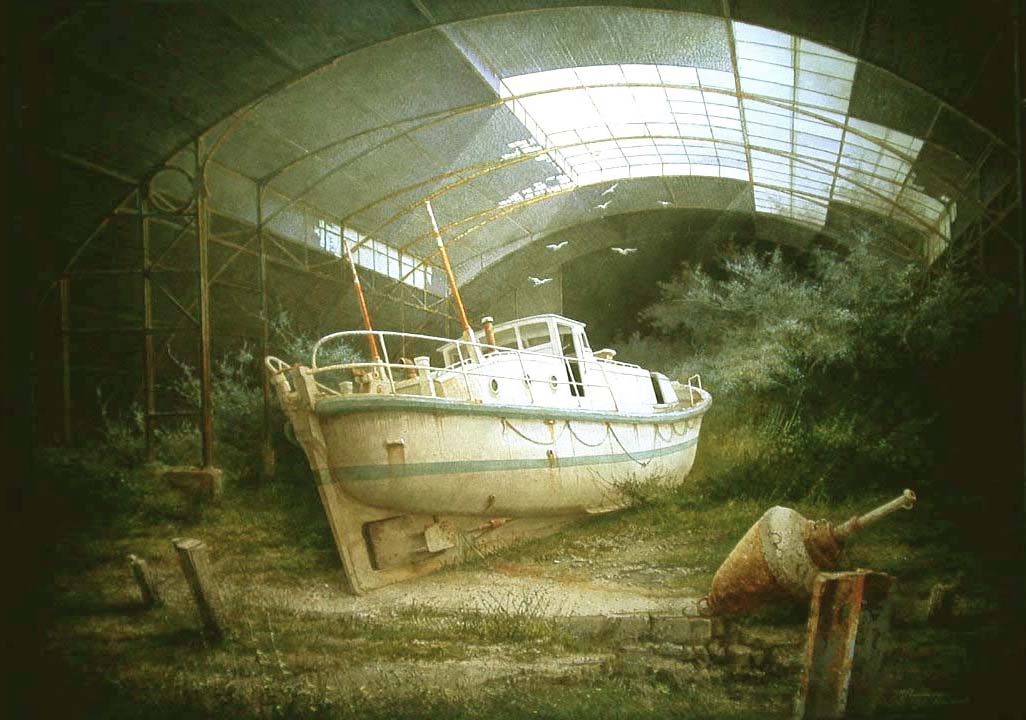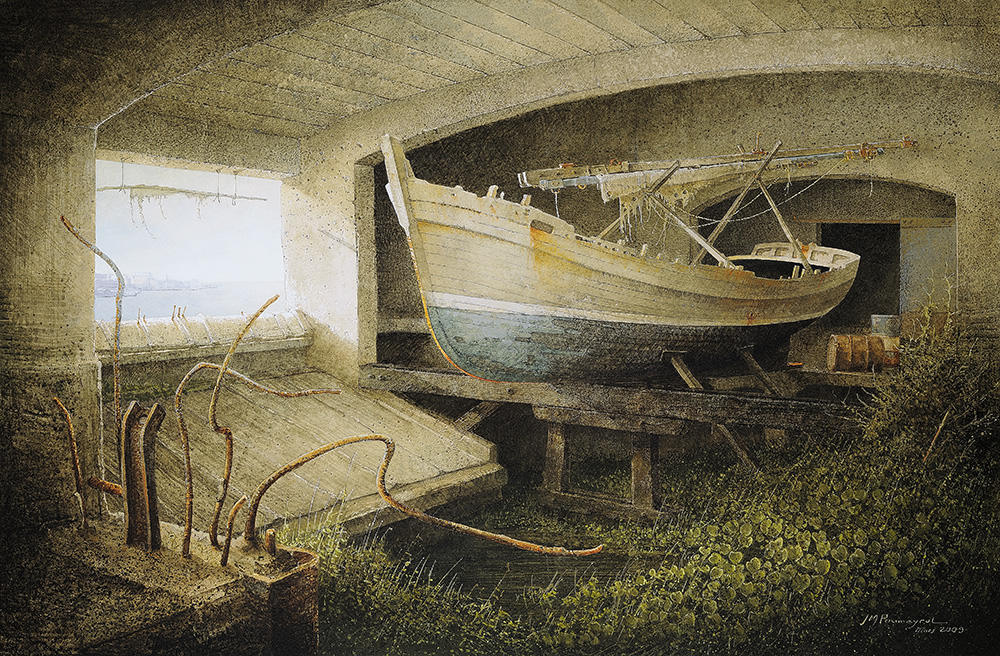Jean-Marie Poumeyrol was born in Libourne, France in 1946. The feeling of boredom that always accompanied him allowed him to develop very early an acuity of vision worthy of an entomologist. A gift for drawing, a powerful distraction for this boredom, did not escape the watchful eye of his mother who showed great sagacity by enrolling him in a private lesson. This initiation combined with his skills allowed him to pass, while he was still only sixteen years old, the entrance exam to the Ecole des Beaux-Arts in Bordeaux, of which he became the youngest student, and of which he graduated with a degree in painting in 1968 and in engraving in 1969. He began in erotic painting which brought him great success and fame. He now lives in Pau and has not painted since 2011 due to illness. His work has been the subject of numerous publications in France and abroad and numerous acquisitions by national museums.
The world he describes is linked to his personal history and his visual anchoring, precise memories stored from the age of six, his immediate environment, Libourne, the banks of the Isle, his wanderings and discoveries first on foot, then with his little boat during his travels on the Isle. The world then expanded a little, the banks of the Garonne traveled for a long time by bicycle brought him to the gates of Bordeaux. This territory seemed immense to him when he was a child. He hardly tried to surpass him thereafter. He remained fascinated by the abandoned industrial sites, the locks of the Isle lateral canal, the blockhouses of the Atlantic Wall, the Bordeaux submarine base, all these sites shaped by man where concrete and scrap metal reign will become formidable places in the etymological sense (which inspire terror) where the visual and the imagination can give free rein.
The paradox in Poumeyrol's realistic, almost photographic painting is that it does not claim to represent "real life": it is a reality deferred and reconstituted only through the filter of memory, the sieve of souvenir and imagination. The term he prefers to describe his approach is that of transfigured reality. His paintings are true stagings only composed in the studio, because he never painted or drew on the motif. If everything seems true, we can never emphasize enough the acuity of his perception from childhood and the impression, in the literal sense, which followed. As he himself says: “The passage of time makes memory selective and rids it of superfluous elements to finally restore only the essential or the most significant”. Through the powerful framing, playing on the different forces of perspective, through the dramatization, the viewer is brought into a phantasmagorical world but where all the elements taken in isolation are true.
Everyone knows that painting is an illusion and that, as Matisse said, to express an emotion or an impression it was necessary to transcribe it. Poumeyrol chose to express his feelings through the most accurate rendering possible of a reality completely recomposed by the imagination. He often repeated that he painted, not to impress with his dazzling technique, but to move. A bit like an entomologist, he fixes fragments of beings, memories, relics, scraps of landscapes or abandoned buildings with clinical rigor. Poumeyrol engages in an unusual approach which makes him the archaeologist of his own memory. His painting is technically extraordinary, meticulous, slowly developed, without any material effect, smooth and cold and yet poetic and full of affect. His work is a distanced autobiography which, through the decantation of images and their visual resurgence, covers both the registers of narration and introspection, but it always transcends the anecdotal.
The painter's entire reflection is based on precariousness, on memory and time. We should therefore not be surprised to find in his work the most humble and moving traces of the objects, of the plants which have accompanied our existence: it is them which will survive when time has passed, a bit like the vestiges of formidable vanished civilizations, of which only fragments of fabric, glass or pottery are exhumed. A certain poetic melancholy emerges from this sepia-tinted universe, from these non-places, neither city nor countryside, which have no precise boundaries. One of the keys to his painting, which fascinates with its statism, is found in the confrontation of two seemingly irreconcilable notions: misleading immobility and the sneaky destructive work of time. Beneath an amorphous appearance lies the perpetual tumult initiating change.
He has dealt several times with the theme of the Paysage prisonnier where nature takes its revenge on industrial culture, in a wild and superb reconquest. The locks have had their day, bathing establishments have gone out of fashion in favor of thalassotherapy. And the most proud constructions are also the most mistreated: the forts, the blockhouses, the ponds. Nature and time overcome all bunkers. His vision of the world is divided between the desire to reflect the humble beauty of everyday life and to show that, whatever man does, nature is always sovereign and that there is no point in going against the order of things.
Wheel of Fortune and reflection on decadence, regrets for what was and is no longer, vanity of human pretensions, only lessons to meditate on. What emerges from his painting is a true fatalist philosophical ethic, often mixed with tenderness, towards the vanity of human endeavors and the irreversible course of time. The inevitable is recurring in his universe, sometimes obvious, sometimes encrypted. But he defends himself from any morbidity. Even though he depicted a certain number of tombs, he considers that there is always an element of rebirth in these paintings. Sic transit gloria mundi…said the Scriptures. So the world goes, concludes with a certain irony Poumeyrol who, if he is sensitive to poetry and the grandeur of ruins, does not forget to act as a philosopher and moralist as Du Bellay or Piranese did in their time. He delivers to our contemplation Les Antiquités of the 20th century.
“To live is to persist in completing a memory. » This quote from René Char could constitute Jean-Marie Poumeyrol's credo regarding his life's work. He too is an archaeologist of memory, an excavator of oblivion, a Marcel Proust of our time. Without grandiloquence, he searches through the chaos of the world for scraps of eternal permanence.
Text by Michèle Heng & Jonk
Based in part on the works:
Poumeyrol by Michèle Heng, Ed. Atlantica, 2001
Poumeyrol, Margins by Michèle Heng, Ed. Atlantica, 2009
Poumeyrol: Transfigured reality by Gerd Lindner, Chantal Puffe, Jean-Marie Poumeyrol, Michèle Heng, Ed. Panorama Museum, 2015

1982
54x90cm
Acrylic on paper

1984
81x116cm
Acrylic on panel

1987
93x59cm
Acrylic on panel

1987
89x116cm
Acrylic on panel

1993
83x57cm
Acrylic on paper

1993
61x89cm
Acrylic on paper

1994
130x89cm
Acrylic on panel

1996
93x130cm
Acrylic on panel

1999
130x89cm
Acrylic on panel

1999
81x116cm
Acrylic on panel

2003
97x130cm
Acrylic on panel

2007
130x89cm
Acrylic on panel

2008
116x81cm
Acrylic on panel

2009
65x100cm
Acrylic on panel

2009
130x89cm
Acrylic on panel

2009
97x130cm
Acrylic on panel

